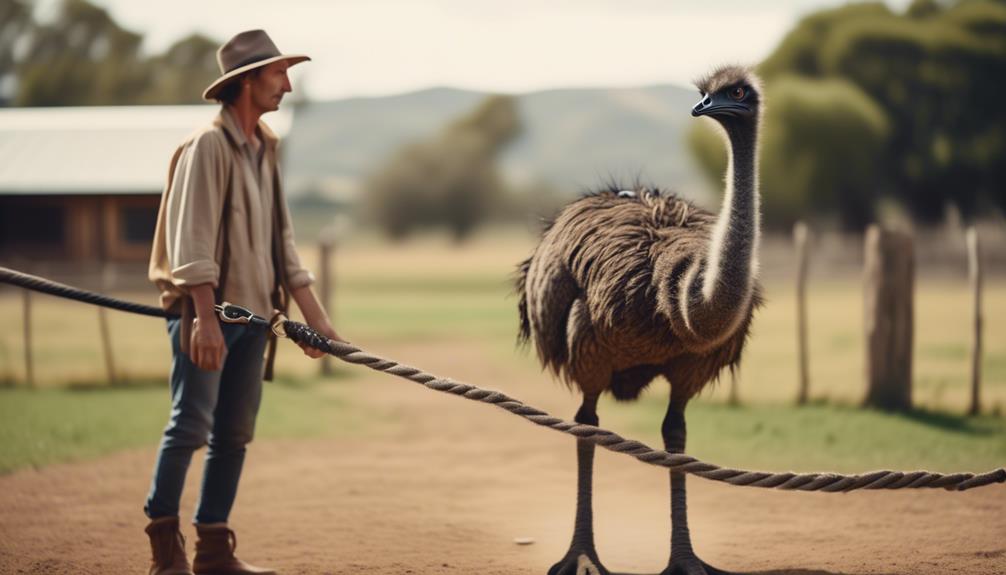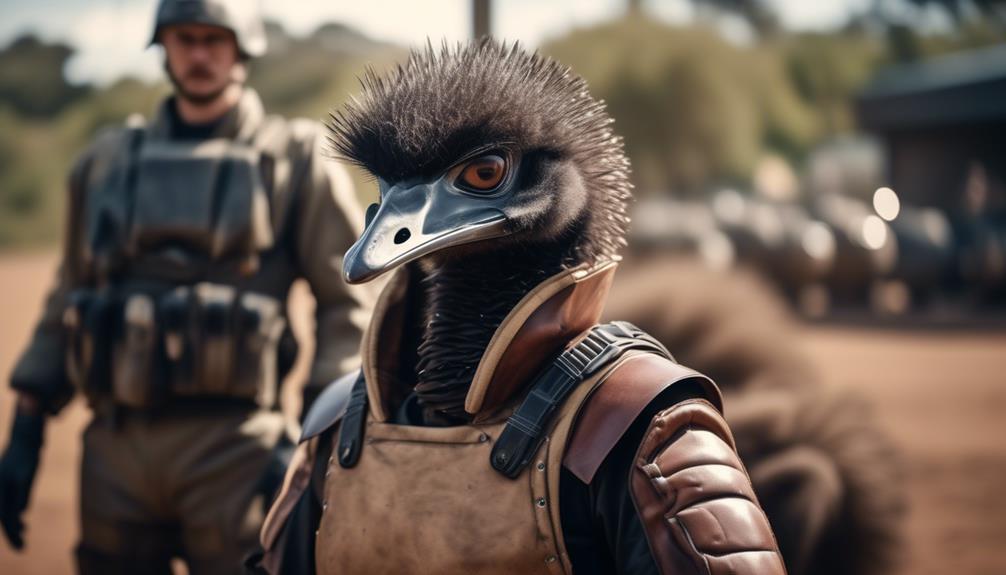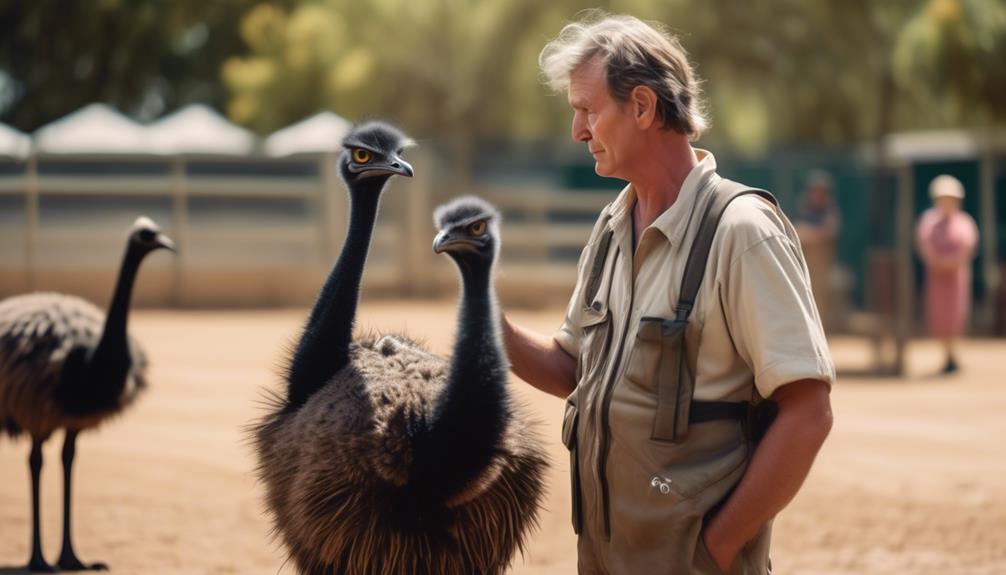
Have you ever found yourself in a situation where you encountered an aggressive emu? These large, flightless birds may seem harmless from a distance, but when provoked, they can become quite dangerous.
Knowing how to handle an aggressive emu safely and effectively is crucial for your own protection and the well-being of the bird. In this discussion, we will explore various techniques and strategies to control and manage aggressive emus, ensuring both your safety and theirs.
So, let's dive into the fascinating world of emu behavior and discover the best ways to handle these magnificent creatures.
Key Takeaways
- Understanding emu behavior and communication cues is crucial in preventing aggressive encounters.
- Maintaining a safe distance, using calming techniques, and carrying deterrents can help diffuse aggressive situations.
- Wearing protective gear and establishing clear boundaries are important for personal safety when handling aggressive emus.
- Seeking professional help and taking preventive measures can ensure long-term safety and avoid legal consequences.
Understanding Emu Behavior

To effectively handle an aggressive emu, it's crucial to have a deep understanding of their behavior. Emus are large flightless birds native to Australia, known for their distinct body language and unique modes of communication. Understanding these communication cues and body language is essential in preventing and diffusing aggressive encounters.
Emus communicate through a variety of vocalizations and physical displays. Vocalizations range from low-frequency rumbling calls to loud booming sounds. These vocalizations serve as a means of communication between individuals, signaling aggression, fear, or territorial boundaries. Paying attention to the tone, pitch, and volume of these vocalizations can provide valuable insights into an emu's emotional state.
Furthermore, emus rely heavily on body language to express themselves. When an emu feels threatened or aggressive, it may puff up its feathers, extend its neck, and make itself appear larger. This display is a clear warning sign and indicates that the emu is ready to defend itself if necessary. On the other hand, if an emu feels relaxed and calm, it may lower its head, droop its feathers, and exhibit a more relaxed posture.
Recognizing Signs of Aggression
Recognizing signs of aggression in emus requires keen observation of their vocalizations and body language. By understanding these signs, you can better prevent attacks and handle aggressive animals.
Emus have a unique way of communicating their emotions, and being aware of these cues is crucial for your safety. When an emu is feeling aggressive, it may emit low-frequency vocalizations, such as deep grunts or hisses. These sounds are often accompanied by body language cues that indicate agitation or threat.
Watch out for raised feathers on their neck and back, as well as an erect posture, with their head held high. Additionally, an aggressive emu may peck at the ground forcefully or make quick, deliberate movements towards you.
It is important to note that emus can become aggressive for various reasons, including feeling threatened, territorial, or protective of their young. By recognizing these signs, you can take appropriate measures to avoid confrontations.
If you encounter an aggressive emu, slowly back away while maintaining eye contact. Avoid turning your back or running, as this may trigger a pursuit response.
Maintaining a Safe Distance

In order to ensure your safety, it's crucial to maintain a safe distance from aggressive emus. These large birds can be unpredictable and potentially dangerous if they feel threatened or cornered. By keeping a safe distance, you minimize the risk of provoking an aggressive response. To establish trust with an emu, it's important to respect their personal space and avoid any sudden movements or loud noises that may startle them. The ideal safe distance is at least 10 feet away from the emu, allowing you to observe their behavior while maintaining a level of safety.
In cases where an aggressive emu approaches you, it's essential to have an emergency response plan in place. Familiarize yourself with local regulations and guidelines on how to handle these situations. It's advisable to carry a whistle or air horn to deter the emu and attract attention if needed.
Calming Techniques
When faced with an aggressive emu, employing effective calming techniques can help diffuse the situation and ensure your safety. It's important to remain calm and focused during such encounters.
Here are some desensitization techniques and distraction methods that you can use:
- Desensitization Techniques:
- Slow and steady movements: Emus can be startled by sudden movements, so it's important to move slowly and avoid making any sudden gestures.
- Gentle vocalization: Speaking softly and calmly can help soothe the emu and signal that you aren't a threat.
- Distraction Methods:
- Offer food: Emus are curious creatures and can often be distracted by food. Tossing a handful of seeds or grain away from you can divert their attention.
- Use a prop: Carrying a long stick or umbrella can create a physical barrier between you and the emu, giving you time to calmly retreat to safety.
Using Protective Gear

To ensure your safety when dealing with an aggressive emu, utilizing appropriate protective gear is essential. The benefits of wearing protective gear can't be overstated, as it acts as a barrier between you and the potentially harmful pecks and kicks of an aggressive emu. Proper gear selection is crucial to ensure maximum protection.
When it comes to protective gear, there are a few key items you should consider. First and foremost, a sturdy helmet is a must. Emus have powerful beaks and can cause serious head injuries if they strike. A helmet with a face shield provides added protection for your face and eyes.
Additionally, wearing thick, long-sleeved clothing can help protect your arms from scratches and bites. Another important piece of gear is a pair of durable gloves. Emus have sharp claws that can leave painful scratches or cuts. Gloves made of strong material, such as leather or Kevlar, can protect your hands from these potential injuries.
Lastly, don't forget about your feet. Emus have strong kicks that can cause severe damage. Wearing steel-toed boots or shoes with reinforced toes can help protect your feet from these powerful blows.
Establishing Boundaries
Establishing clear boundaries is crucial when dealing with an aggressive emu to ensure your safety and effectively manage the situation. When faced with an aggressive emu, it's important to set limits and communicate assertively. Here are some key strategies to help you establish boundaries when dealing with an aggressive emu:
- Maintain a confident posture: Stand tall, hold your ground, and avoid any sudden movements that may provoke the emu further.
- Use assertive communication: Speak in a firm and calm tone, using clear and concise commands such as 'stop' or 'back off' to assert your authority.
- Avoid yelling or screaming, as this may escalate the situation.
- Keep your voice steady and composed to maintain control.
Seeking Professional Help

If you're unable to effectively manage an aggressive emu on your own, it's advisable to seek professional help. Emus can be unpredictable and their aggressive behavior can pose a threat to your safety. Thankfully, there are emu rehabilitation programs available that specialize in handling and rehabilitating aggressive emus.
When seeking professional help, it's crucial to choose a reputable and experienced emu specialist. These professionals have the knowledge and skills to safely handle and control aggressive emus. They can assess the situation, develop a suitable plan, and implement effective strategies to manage the emu's behavior.
Engaging with a professional not only ensures your safety but also helps to avoid any legal consequences that may arise from aggressive emu encounters. In some regions, aggressive emus may be protected by laws, and causing harm to them can result in legal issues. By seeking professional help, you can navigate these potential legal complexities and ensure that you're acting within the boundaries of the law.
Preventing Future Encounters
Once you have sought professional help to manage an aggressive emu, it's essential to implement preventive measures to avoid future encounters. By taking the necessary steps to avoid confrontation and emu-proof your surroundings, you can ensure your safety and the safety of those around you.
Here are some tips to help you prevent future encounters with aggressive emus:
- Secure Fencing: Install sturdy and high fencing around your property to keep emus out. Make sure the fence is at least 6 feet tall, as emus are excellent jumpers.
- Remove Attractants: Emus are attracted to food sources, so it's crucial to remove any potential attractants from your property. Keep garbage cans tightly sealed, clean up fallen fruits or vegetables, and avoid leaving pet food outside.
- Secure Gates and Doors: Ensure that all gates and doors are securely closed and latched at all times. Emus are known to be curious and may explore open areas.
- Avoid Provoking Behavior: Don't approach or corner an emu, as this can escalate their aggression. Make sure to give them ample space and avoid sudden movements or loud noises.
Frequently Asked Questions
What Is the Average Lifespan of an Emu?
The average lifespan of an emu is around 10-20 years. They have unique breeding patterns and require a diet of fruits, seeds, and plants. Taking care of an emu involves understanding their specific needs.
Are Emus Native to Australia?
Yes, emus are native to Australia. However, they have also been introduced to other countries and have become an invasive species. Conservation efforts in Australia aim to manage their population and protect native habitats.
Can Emus Fly?
Emus cannot fly. They are large, flightless birds native to Australia. Understanding emu behavior is crucial for effective emu aggression control. Safety and control measures should be implemented when dealing with aggressive emus.
How Fast Can Emus Run?
Emus are remarkably fast runners, reaching speeds of up to 30 miles per hour. It's important to understand their aggression patterns in order to effectively handle them.
Do Emus Make Good Pets?
Owning an emu can be both rewarding and challenging. They are unique and can form strong bonds with their owners. However, it's important to consider the legal requirements and the potential for aggression.
Conclusion
In conclusion, when faced with an aggressive emu, it's crucial to prioritize safety and control.
By understanding emu behavior and recognizing signs of aggression, you can effectively maintain a safe distance and use calming techniques to de-escalate the situation.
Additionally, utilizing protective gear and establishing boundaries can further ensure your safety.
If needed, seeking professional help is always a wise choice.
Remember, just like handling an aggressive emu, facing challenges in life requires patience, resilience, and a steady hand.




